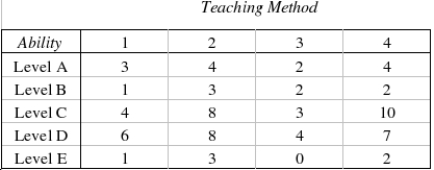Another school district also planned to evaluate two different workbooks and two distinct teaching machines to assess their effectiveness in teaching the concept of multiplication. However, the administrators in this school district consulted a statistician about the design of their study. Because they were looking for a method effective on children of all abilities, the statistician suggested they check the children's past scholastic records and divide the children into groups according to their ability level. These ability groups represent relatively homogeneous experimental units within which the comparison of teaching methods may be made. She assigned one child from each ability level to each teaching method. Twenty students participated in the study. After receiving instruction, the children took a multiplication test and the number of errors they made were recorded.  What experimental design did the statistician use?
What experimental design did the statistician use?
________________________________________________________
The null and alternate hypotheses are as follows:  : The three population distributions are identical.
: The three population distributions are identical.  : At least two of the three population distributions differ in location.
: At least two of the three population distributions differ in location.
Describe what the test statistic  is.
is.
________________________________________________________
Test Statistic:  = ______________
= ______________
Reject Region:
Reject  if F > ______________
if F > ______________
Conclude: ______________
The teaching methods ______________ equally effective.
Estimate the observed significance level of this test.
______________
Correct Answer:
Verified
View Answer
Unlock this answer now
Get Access to more Verified Answers free of charge
Q21: A three independent samples one-way analysis of
Q22: A toy store manager was interested in
Q23: The following data were generated from a
Q24: If Friedman test is applied to a
Q25: The reaction times to three stimuli were
Q27: A randomized block design analysis of variance
Q28: To apply the Friedman test to determine
Q29: The restaurant critic on a newspaper claims
Q30: The Friedman test is the nonparametric counterpart
Q31: In a Friedman test for comparing three
Unlock this Answer For Free Now!
View this answer and more for free by performing one of the following actions

Scan the QR code to install the App and get 2 free unlocks

Unlock quizzes for free by uploading documents